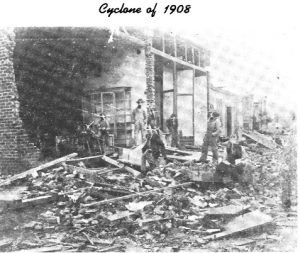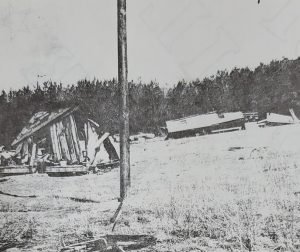By Kate Stow
Nothing changes in East Texas more than the weather; and that’s one thing that hasn’t changed. Following are some early accounts of severe weather during the early years of Atlanta.
The coldest winter
In a 1979 Journal, Yvonne Vestal wrote about the early cold winters Atlanta experienced.
The coldest temp ever in Atlanta may have been the “terrible cold spell of Dec 1885. The cold was so great that it would freeze the inside of the trees causing its bark to burst with a loud explosion like artillery,” wrote Will C Hornsey in commemorative stories written in the 1950 Journal.
On “Cold Sunday” of 1899 temperatures dropped to 17 degrees below zero. Throughout Texas the weather was the same and provisions were made for people to occupy courthouses and other dwellings where they could stay warm.
Hornsey went on to say “I do not mean to make anyone jittery right here when I express myself saying if such a cold spell should visit Atlanta, Texas as it did on that cold day in Dec 1885 or on that “cold Sunday” in Feb 1899 I believe that our gas stoves would not give us the necessary heat, and there is a possibility that the flow of natural gas would be frozen by the extreme cold temperatures and all of us might suffer agony or death from this extreme cold. When that ‘Cold Friday’ came and that ‘Cold Sunday’ the people then had big woodstoves and fireplaces and wood to burn which gave me very little comfort and protection, but now our source of fuel is natural gas.”
In the March 13, 1899 issue it was reported that “many peach trees will not bloom this spring owing to the hard freeze.”
Also included in the story were these fun facts: Atlanta once experienced five successive snows on the 21st of each month: Nov 21, Dec 21 of 1929, and Jan 21, Feb 21 and March 21 of 1930; During the cold spells before 1900, people gathered in the courthouse for warmth.
Tornadoes, Whirlwinds and Cyclones
Since the founding of the United States, reports of whirlwinds and cyclones have turned into reports of tornadoes. When the Fujita Scale was developed in 1971, these storms were given ratings to measure their severity.
The April 28, 1898 issues of the Journal reported: “A destructive cyclone last Friday five miles southwest of Atlanta, killing two people, Mr. and Mrs. George Jackson, and several other people were more or less seriously injured.”
The May 2, 1912 Journal had this front page headline: “Cyclones Prevailing”
“Last Saturday a destructive cyclone formed near Childress, Texas and destroyed a number of homes, four dead and several injured. The cyclone passed through Oklahoma, a hundred miles, destroying many homes in its path. More than 20 people were killed in its path. Sunday there were cyclones all around Atlanta, west of town. E.C. Rogers kitchen was blown from blocks and turned partly around. Mr. Cross’ house was unroofed. At old Dempsey, a storehouse on the KCS was blown away entirely and the big trees blown down. J.H. McWilliams had gone down to Mr. Parkers in Beat 6 in the morning and says in returning Sunday evening he found many trees and telephone poles across the road. Reports of heavy storms in other portions of the country with one death – Mr. Hanley Harris in Linden.”
The Big Storm
Sam Wall was born in Cass County in 1880. Some time before his death in 1974 he was interviewed for the Journal about things he remembered from his life here, including a big storm. “I bought this place in Oct 1918. I was living here in my house a the time of the cyclone. The next day after the cyclone I went up to see what it had done. I came back and talking to Joe Richards at Springdale. He later went and looked for himself and said ‘he didn’t believe me, he didn’t think it could be that bad but after seeing it, he thought it was worse than I said.’
“I saw a tree standing up with a whole fence rolled upon it. It blew a house away all but the floor. You couldn’t see a board or nail, it was so clean around that floor. I saw Scott Davison’s place and John C. Adams’ place where it blew their house away – it drew all the water out of a well, blew Billy Monzingo up and down three times and left him in the well He yelled and someone heard him and they pulled him out. The well never did have anymore water in it.
“His little daughter was killed and I think he went back to Alabama. Sill Rogers that maried the Thompson girl – it blew his house away. Howard Watts, he was trying to make a preacher, it made a circle around his house, leaving it standing but blowing other houses down – Isn’t that a miracle? Could see bark with feathers blown into it, also pine needles and all. There was some timber south and southwest from here that was piled together just like my fingers.”
Cass County Swept by Cyclone
In the April 21, 1921 issue of the Journal, this article appeared:
“The most destructive cyclone in the history of this county struck this section last Friday afternoon. It came from the Southwest and traveled in a Northeasterly course doing damage at Mineola, Gladewter, Gilmer, in Harrison County, striking Cass County at Avinger and passing out about Stone Coal Bluff or Sulphur Station, cutting a path estimated from a half to a mile wide clear across the country, doing hundreds of thousands of dollars in damage and taking a toll of eleven lives, with several more seriously injured and many slightly injured. Something over one hundred homes were destroyed in Cass County.
“The destruction left in the path of the cyclone is beyone description. In many places large trees are twisted off at the ground and the trunks carried for hundreds of yards. Houses were totally destroyed, and the timbers blown completely away. A heavy hail storm accompanied the cyclone and doing untold damage to growing crops where the wind would not have damaged them.
“A part of the roof of Frank Haynes barn was found on Hickory Ridge, about four miles from his home. It had been stuck up in the ground and then broken off and the balance of it carried away. Acres of shingles, leaves, twigs, etc were twirling through the air in Linden 20 minutes before the full force of the wind hit there. The roaring of the wind was heard for many miles away from the stricken section.
“It is said the school house at Spences’s Chapel was so torn up that not one piece of timber from it has been found. It was the last day of school there and teachers and pupils had gone to the creek fishing that afternoon.
The work of relief was delayed on account of the roads being impassable it being necessary for crews to take saws and axes and cut away through before the homes of those living in that section could be reached.”
Another accounting of that storm was told in a 1979 issue of the Journal, and follows: On April 21, 1921, another cyclone struck. Mrs. Elva Upchurch was a young girl at the time, living with her family on Hickory Nut Mountain west of Queen City. “I stood on the back porch with my dad and listened to the roar. It pulled up all the big trees on the south side of Hickory Nut Mountain and took them over the mountain,” she said.
The Storms of 1928
On February 9, 1928 a cyclone was reported in Rambo. A kitchen and side room were blown from a house.
The April 26, 1928 issue of the Journal tells of a “severe storm” that struck Marietta. One person suffered from a broken collar bone when she was struck by flying timber while running into a storm cellar. A barn was wrecked, buildings damaged, a residence blown off the blocks, a chimney blown down and a barn blown over. Evidently, Springdale was hit by the same storm. A barn, some timber and outbuildings were blown down. Some chickens were killed, a mule killed, and a man and women injured.
The Lineman’s Lament
Oval Harden, who spent 34 years as Atlanta’s SWEPCO manager from 1936 to 1970, recalls the worst weather because it made his job hard. In a Feb 15, 1976 Journal article he recalled a 1946 hurricane in which the winds blew down all of Atlanta’s power lines.
“We were without electricity from 10pm Saturday until 2 pm the next day and that’s the only time we had a fatality while I worked for SWEPCO,” he said.
But the most severe electrical problems occurred in 1961 when an ice storm hit the area and Harden recalls not lying down for sleep from Tuesday till Friday night. “The peculiar thing about an ice storm is that when the ice melts off the lines, they begin to sag and go up and down. Lines come into contact with other lines and it burns them down. Then limbs begin falling on them.”


